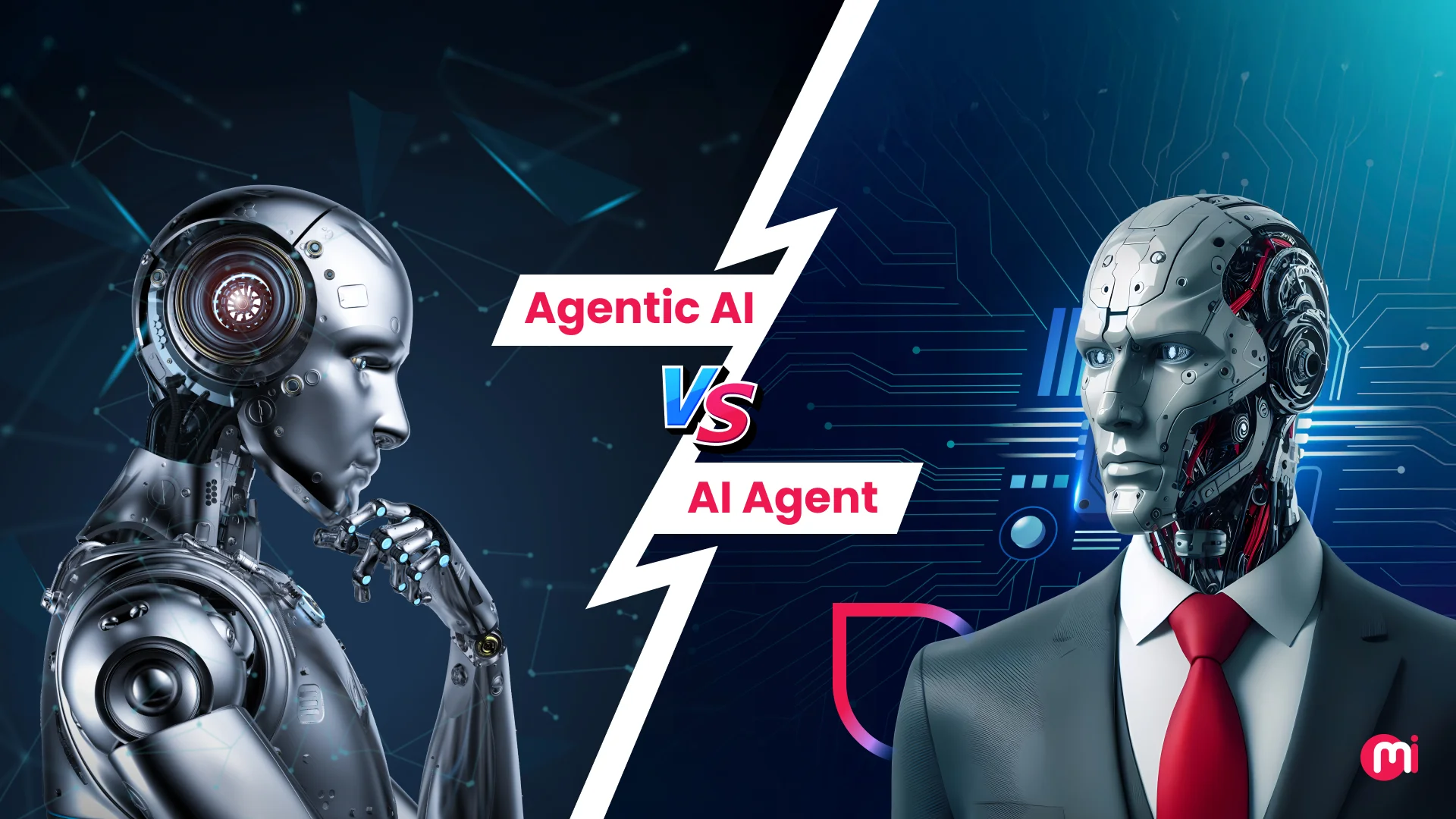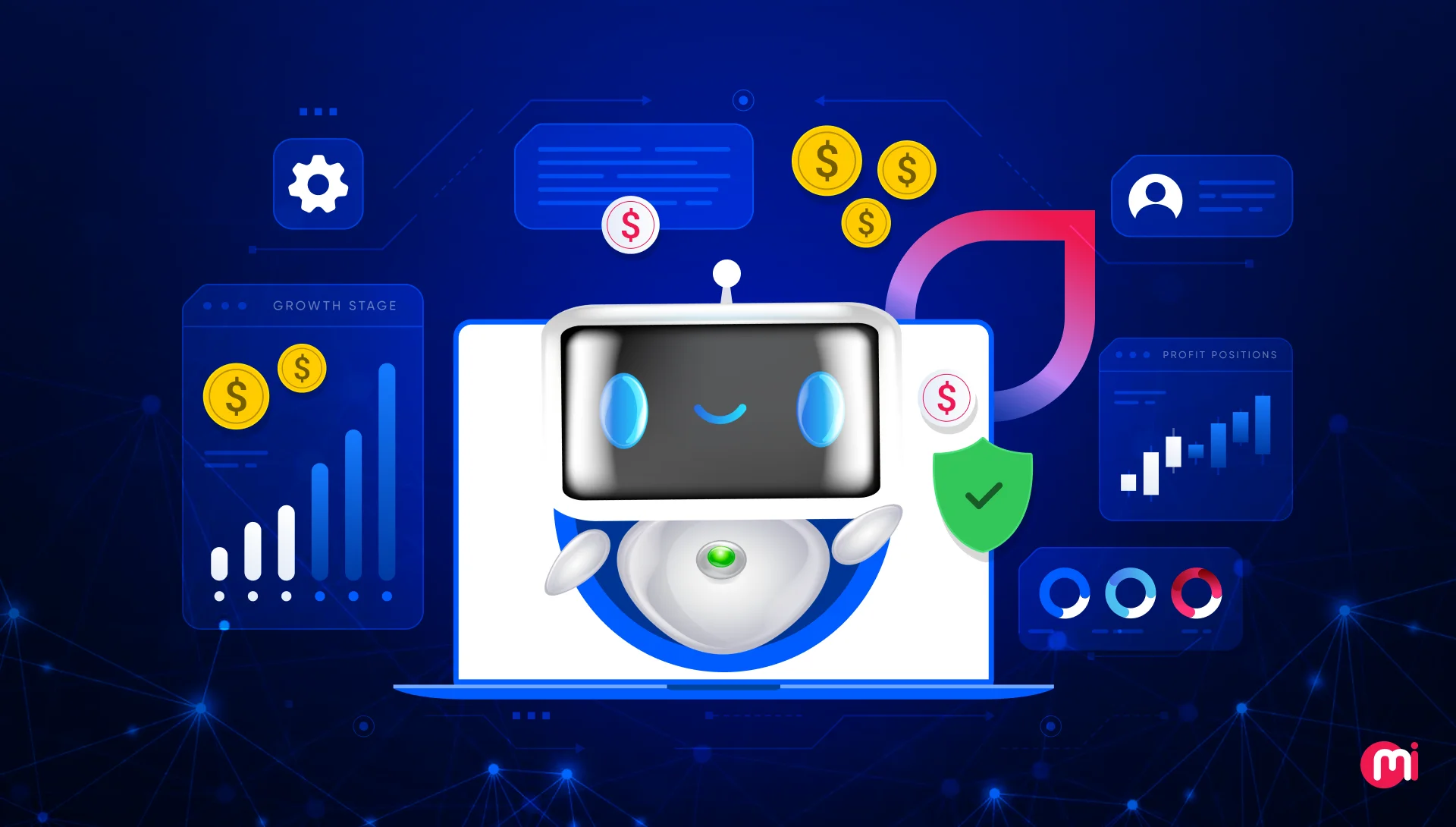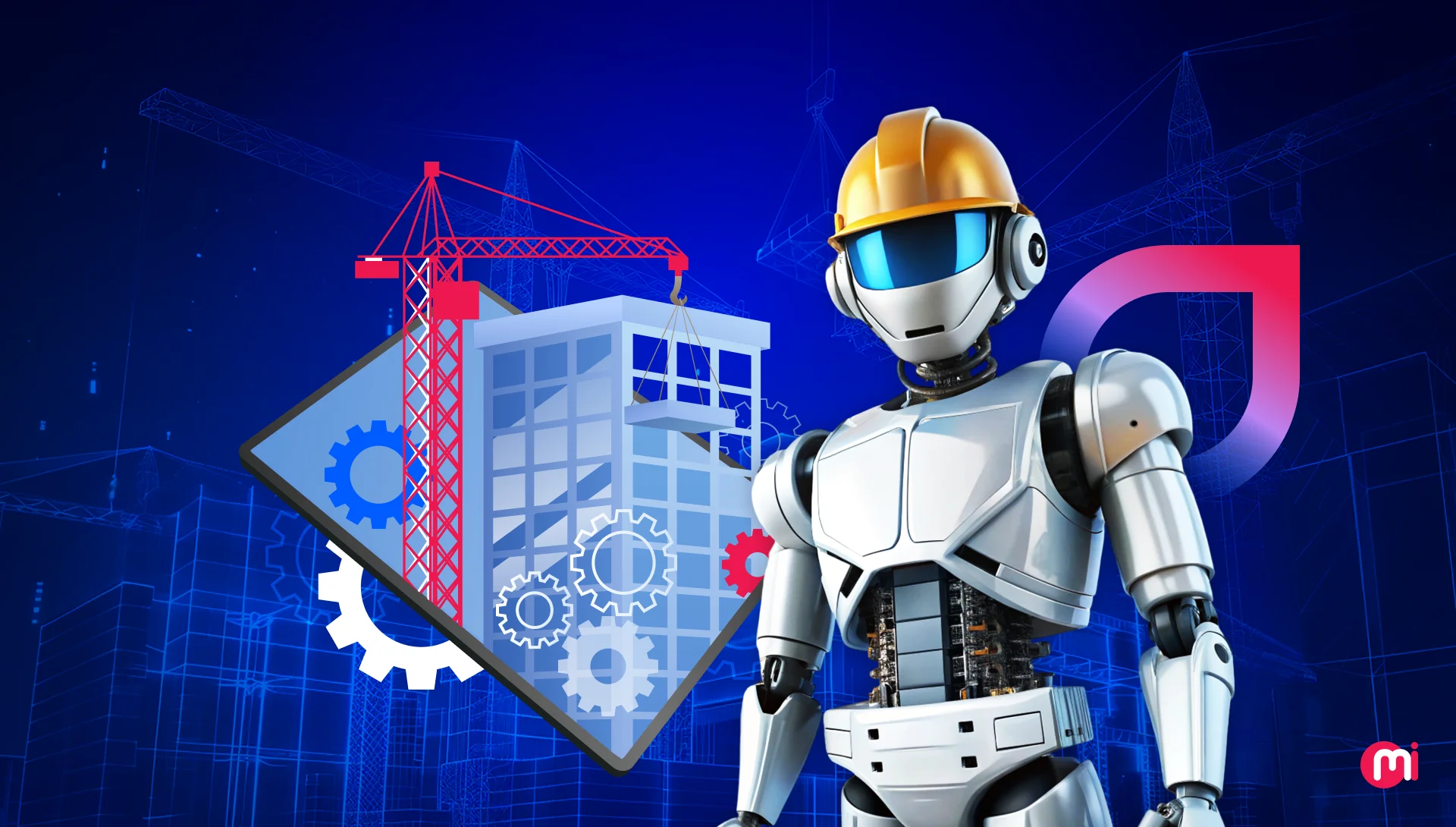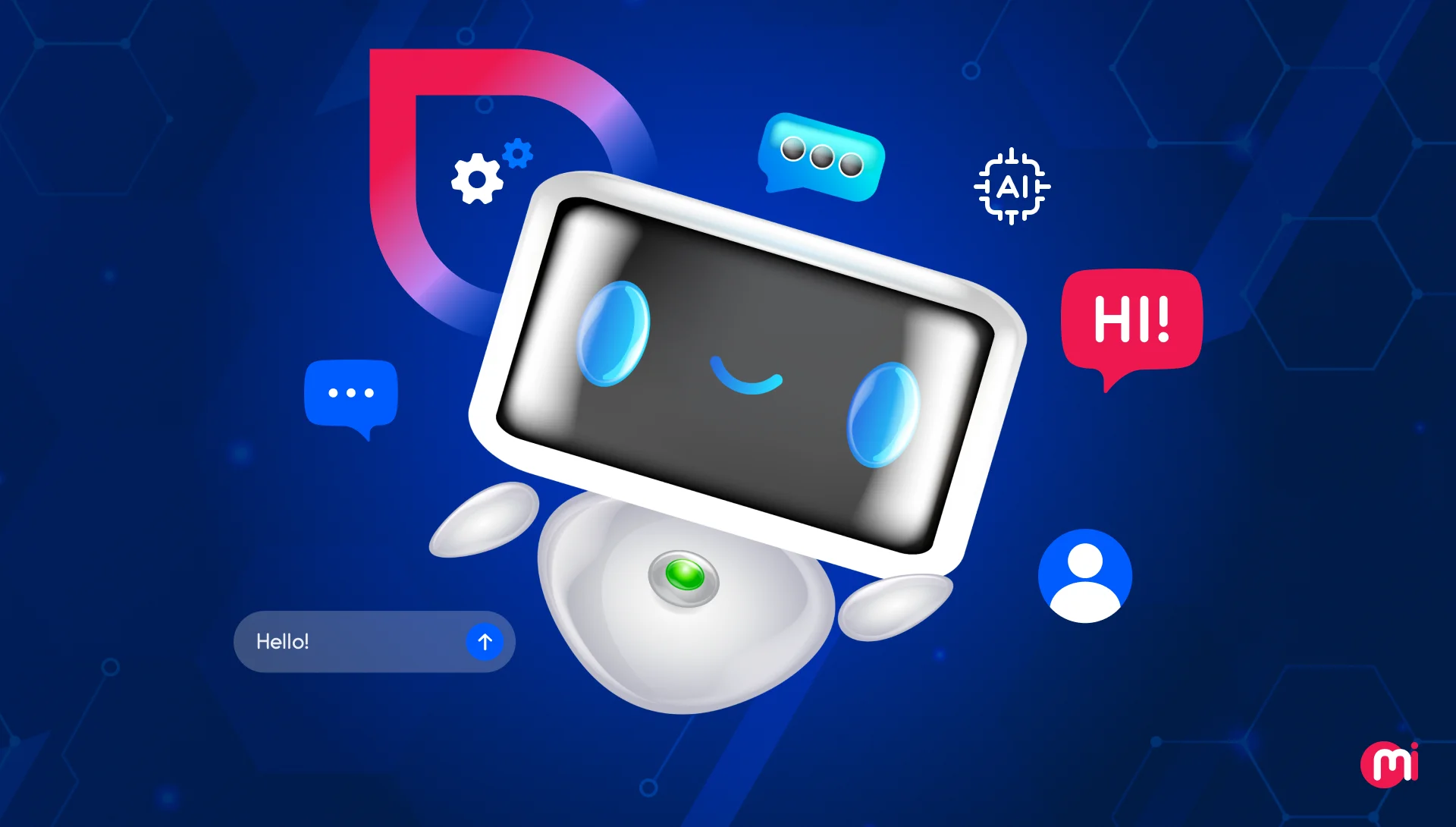Agentic AI vs AI Agent: Differences You Need To Know Before Choosing The One
- AI/ML
- May 7, 2025
For decision-makers planning to invest in AI, the agentic AI vs. AI agents comparison is a critical topic of discussion. Agentic AI systems are designed to pursue goals, adapt, and make decisions independently, while AI agents focus on executing assigned tasks. Both technologies offer clear value, but serve different operational needs. This blog breaks down their differences, helping them make an informed decision before the investment.
Agentic AI vs AI Agent; When To Integrate What Technology?
The question is beginning to shape conversations as systems grow more advanced and autonomous. On the surface, both technologies seem designed to solve problems and handle tasks, but the way they operate — and the possibilities they unlock are fundamentally different.
Choosing between them isn’t about preference; it’s about understanding the architecture, level of autonomy, and the role intelligence plays in real-world environments. The right choice depends on the kind of system you want to build and how your system executes instructions within set boundaries or defines its pathways, adapts to changing conditions, and makes decisions beyond pre-written rules.
This blog will break down the core distinctions between agentic AI vs. AI agent, and explore their strengths and strategic implications in your business.

What is Agentic AI?
An autonomous AI agent is an artificial intelligence system designed to perform specific tasks or solve problems based on predefined goals and instructions set by humans. An autonomous AI agent operates within a clear boundary: it senses its environment, processes information, and takes actions that align with its assigned objective.
Think of traditional AI as a GPS that follows a set route you’ve given it, while agentic AI is more like a self-driving car that not only chooses the best route based on real-time traffic but can also decide where to go based on your calendar, habits, or goals—without needing you to tell it each step.
Key Statistics Supporting Growth of Agentic AI
By 2028, Gartner predicts that:
- 33% of enterprise software will integrate agentic AI.
- 20% of digital storefront interactions will be handled by AI agents.
- 15% of daily decisions will be taken autonomously, dramatically transforming decision-making processes.
Notable Characteristics of Agentic AI
- Goal-driven behavior
- Autonomous decision-making
- Contextual awareness and self-directed learning
- Ability to plan and adapt actions over time
- Minimal need for human intervention
What is an AI Agent?
An AI agent is an artificial intelligence system designed to perform specific tasks or solve problems based on predefined goals and instructions set by humans. An AI agent operates within a clear boundary: it senses its environment, processes information, and takes actions that align with its assigned objective.
For example, you give it a goal or task, and it works within those instructions to get it done. It can sense what’s happening around it, process that info, and act accordingly—but it doesn’t come up with its own goals or change direction on its own. Think of it like a smart assistant that follows your commands: efficient, reliable, but not making big-picture decisions for you. To explore some of the most efficient and widely-used examples, check out this list of the best AI agents shaping various industries today.
Key Statistics Supporting Growth of AI Agents
- The AI agent market is experiencing explosive growth, projected to reach an astounding $47.1 billion by 2030.
- AI agents for enterprises are rapidly gaining traction across various business applications, and the market for AI agents is anticipated to grow at an impressive 45% (CAGR) over the next five years.
- According to Business Insider, leading consulting firms such as McKinsey, BCG, and Deloitte have embraced AI agents within their operations. At McKinsey, for example, over 70% of the company’s 45,000 employees use its proprietary AI chatbot, Lilli, to support tasks like research, data analysis, and problem-solving.
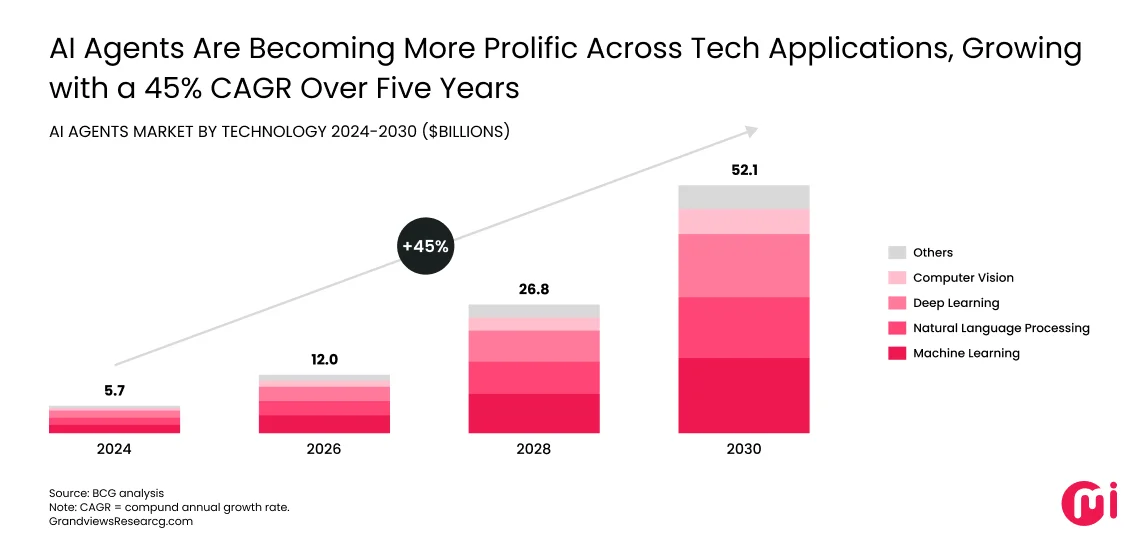
Notable Characteristics of AI Agents
- Task-specific intelligence
- Reactive and proactive behavior
- Human in-the-loop dependence
- Integration-friendly design
- Limited autonomy
Agentic AI vs AI Agent: Key Differences
As AI technology trends are getting traction in the market and the use of AI and ML are transforming business processes, new inventions are coming out. Among which two terms are shaping modern automation conversations — agentic AI and AI agents. Though both aim to offload human effort and boost efficiency, they operate on distinctly different philosophies when it comes to autonomy, adaptability, and complexity. Here’s how they truly differ:
Agentic AI vs AI Agent: A Quick Overview
| Category | Agentic AI | AI Agent |
| Goal Orientation | Defines and pursues goals autonomously Suitable for dynamic, outcome-driven systems Adjusts goals based on evolving context and priorities | Executes clearly defined objectives with precision Ideal for structured, rule-based environments Maintains consistency and predictability in task performance |
| Context Awareness | Interprets broader system context and variables Adjusts actions based on environmental and situational shifts Useful in complex, interdependent environments | Performs reliably within a known and stable context Effective for tasks where external variables are limited Ensures accuracy by focusing on the task-specific data |
| Lifecycle Management | Continuously evolves based on feedback and outcomes Adapts autonomously without constant retraining Reduces manual maintenance for the long-term scalability | Easy to monitor and control with clear retraining cycles Updates are managed systematically through human oversight Ensures stable performance with minimal unpredictability |
| Cross-Domain Functionality | Operates across domains with flexible strategies Learns transferable patterns and applies them across contexts Effective for systems that require cross-functional coordination | Excels in specialized domains where accuracy and efficiency are key Highly optimized for single-purpose applications Integrates well with domain-specific tools and workflows |
Agentic AI vs AI Agent: Purpose
Agentic AI acts as an autonomous, goal-driven entity capable of independently setting sub-goals, making strategic decisions, and adjusting its actions in a real-time to meet an overarching objective even as the environment or data changes.
Its purpose isn’t limited to task execution but extends to achieving desired outcomes through self-directed reasoning, learning from feedback loops, and navigating complex, unpredictable scenarios without ongoing human input.
In contrast, AI agents execute task-specific roles where pre-programmed logic or workflows define and bind their purpose. These agents follow instructions, automate repetitive processes, and enhance productivity, but they do not actively set goals or reshape their objectives on their own.
| Point to Consider: When it comes to purpose, agentic AI and AI agents are built with fundamentally different intentions at their core. Choice must depend on the integration purpose. |
Agentic AI vs AI Agent: Decision-Making
Agentic AI is designed for autonomous, context-aware decision-making as it can evaluate situations, set priorities, adjust strategies, and even resolve conflicting goals without needing constant human input. This makes agentic AI valuable in dynamic, real-world environments where conditions shift and rigid logic falls short.
On the flip side, AI agents are confined to making decisions within predefined rules and structured workflows. Their purpose is to execute specific tasks and make choices based on program triggers rather than self-generated goals or adaptive reasoning.
| Point to Consider: When it comes to decision-making, the contrast between AI agents vs agentic AI reveals the true difference in their intelligence and operational depth. The key difference is that agentic AI decides how to act to achieve a broader goal, while AI agents simply choose the next step based on instructions already set by humans. |
Agentic AI vs AI Agent: Learning Capabilities
Agentic AI systems are designed to continuously learn from their environment, feedback, and outcomes, refining their strategies and even adjusting their goals as they gather more data over time. This form of self-directed learning allows them to improve autonomously without the need for constant human retraining or manual updates.
In contrast, AI agents rely on static training models or supervised learning approaches, which means their ability to improve is dependent on human developers supplying new data sets or rule adjustments.
| Point to Consider: Hence, in AI agent vs agentic AI comparison, AI agents excel at providing known solutions to known problems, and agentic AI evolves beyond its initial programming, learning how to solve new, unforeseen challenges as it encounters them. This makes agentic AI better suited for complex, changing environments, whereas AI agents remain powerful for predictable, task-focused scenarios. |
Agentic AI vs AI Agent: Autonomy Level
Agentic AI is designed to function with a high degree of autonomy, and it can define sub-goals, make strategic choices, and navigate unexpected situations without waiting for human direction or sticking to rigid task boundaries. Its architecture allows it to pursue long-term objectives even as the surrounding conditions evolve.
On the other hand, AI agents are built for lower levels of autonomy, where their actions are confined to following predefined rules, workflows, or human-set triggers. They require clear instructions and rely on humans to set the purpose, outline the limits, and intervene when conditions fall outside their programmed scope.
| Point to Consider: When it comes to autonomy level, the difference between AI agents vs agentic AI highlights how independently these systems can operate. It’s evident that agentic AI excels in situations requiring flexibility and autonomy, whereas traditional AI agents are more effective in structured, predictable, and human-guided settings. |
Agentic AI vs AI Agent: Scope of Action
Agentic AI is built to handle open-ended, multi-dimensional scenarios where the end goal is defined but the path to reach it is not. Its scope of action is dynamic as it explores options, changes strategies, and selects actions that weren’t explicitly pre-programmed, as long as they align with the intended outcome.
Opposite to it, AI agents are typically bound to a specific, pre-defined scope of action, which is usually limited to performing a narrow set of tasks in a structured environment. They can only act within the parameters programmed by humans and require external input or intervention when faced with scenarios beyond that scope.
| Point to Consider: So when weighing AI agents vs agentic AI, the key difference is flexibility, as agentic AI operates with an expansive, adaptive action range, while AI agents follow a fixed and controlled task boundary. |
Agentic AI vs AI Agent: Human Input Dependency
Agentic AI is purposefully designed to minimize human input once its objective is set. These systems are capable of self-planning, real-time problem-solving, and independently adjusting their behavior as they encounter new data or challenges, reducing the need for constant human oversight. They can operate in complex, shifting environments with little to no manual guidance, making them ideal for scenarios where autonomy and adaptability are non-negotiable.
On the flip side, AI agents depend heavily on human input for both their initial setup and ongoing adjustments. They rely on human-defined rules, clear instructions, and external data feeds to complete their tasks, and any situation beyond their programming usually requires direct human intervention.
| Point to Consider: So when comparing agentic AI vs AI agents, the difference is clear, agentic AI reduces the need for human supervision, while AI agents still require human hands to stay on track and relevant. |
Agentic AI vs AI Agent: Integration with Other Technologies
Agentic AI is built for fluid interoperability, designed to not only connect with diverse tools, APIs, and platforms but to also independently determine when and how to use them to meet its goals. It can actively orchestrate and reconfigure its use of technologies like cloud systems, IoT networks, or data analytics tools in real-time, adapting its integration strategy as business or operational needs evolve.
In contrast, AI agents are typically programmed for static or narrowly scoped integrations, where the connections to other systems are predetermined and usually dependent on human-designed workflows. They function as part of a structured digital environment but lack the autonomy to select or rewire their tech stack on their own.
| Point to Consider: So when it comes to agentic AI vs AI agents, agentic AI integrates technologies dynamically to serve its objectives, while AI agents integrate within predefined limits set by humans. |
Agentic AI vs AI Agent: Responsiveness to Change
As we discussed, agentic AI is specifically designed to detect, interpret, and respond to unexpected changes in real-time whether those shifts are in data patterns, external environments, or system goals. It doesn’t just follow a static workflow but actively re-evaluates its strategies, recalibrates its actions, and modifies its plans on the fly to stay aligned with its objectives.
In contrast, AI agents are typically reactive within the limits of their programmed rules; they can handle predefined exceptions but struggle to adjust when faced with scenarios outside their training scope or logic boundaries. While AI agents require human input to pivot or upgrade their actions, agentic AI embraces change as part of its core operating model.
| Point to Consider: So, when comparing agentic AI vs AI agents, agentic AI thrives on unpredictability, while AI agents perform best in stable, structured environments. |

Use Cases of Agentic AI and AI Agents
Agentic AI and AI agents introduce smart automation and intelligence into business operations. While their core capabilities overlap, their roles in real-world applications differ based on autonomy, adaptability, and complexity. Here’s a quick look at where each thrives:
Use Cases of AI Agents
1. Customer Support
AI agents carry out predefined tasks like answering FAQs, guiding users through troubleshooting, and assisting with basic transactions through natural language conversations via chatbots, voice systems, or email responders. They also excel at handling repetitive, high-volume customer queries which not only speeds up response times but also reduces the burden on human support teams.
According to data from Salesforce, 39% of consumers are already at ease with AI agents scheduling appointments on their behalf. Additionally, 24% of consumers are comfortable with AI agents shopping for them, with 32% of Gen Z consumers expressing the same comfort level.
2. Order and Shipping Management
AI agents streamline operations, automate routine tasks, and ensure real-time accuracy across the entire supply chain. From the moment a customer places an order, AI agents confirm inventory availability, process payment checks, generate order confirmations, and automatically assign shipping carriers based on cost, speed, and destination preferences.
These agents continuously track shipments, update customers on delivery status, and flag delays or exceptions to both users and internal teams without human supervision. More advanced AI agents even optimize delivery routes, predict shipment bottlenecks, and suggest alternative logistics solutions when disruptions occur.
3. Human Resources and Recruitment
AI agents can scan and shortlist candidate resumes based on predefined job criteria, schedule interviews, send follow-up emails, and conduct preliminary assessments through chat-based screenings or skill-testing modules. Beyond hiring, AI agents assist HR teams in onboarding new employees by sharing training materials, managing document verification, and guiding new hires through company policies.
For ongoing HR tasks, AI agents can handle leave requests, benefits inquiries, performance feedback reminders, and even pulse surveys without the need for constant human oversight.
4. Supply Chain Management
The use of AI in inventory management has changed the workflow entirely. AI agents are a part of the shift as they monitor supplier performance, track inventory levels, predict demand fluctuations, and trigger reordering processes in real-time and with minimal human involvement. AI agents analyze data from multiple sources, including market trends, weather forecasts, and shipping routes, to proactively suggest optimized procurement strategies and delivery schedules.
When disruptions arise, like supplier delays or transportation bottlenecks, AI agents can instantly reallocate resources, notify relevant authorities, and propose alternative routes or vendors to maintain continuity.
5. Sales and Service
In sales, AI agents autonomously qualify leads by analyzing customer data, purchase history, and online behavior, helping the sales team prioritize high-value prospects. They can also automate follow-up emails, schedule demos, and even provide product recommendations tailored to individual client needs.
On the service side, AI agents handle everything from answering routine customer queries and processing service requests to offering self-service solutions through chatbots and virtual assistants. These agents work around the clock, ensuring quick responses and smooth handovers to human reps when complex or emotional issues arise.
Use Cases of Agentic AI
1. Autonomous Vehicles
Unlike traditional AI systems that operate within pre-coded rule sets, Agentic AI enables autonomous vehicles to act as goal-driven agents. The primary goal is to safely transport passengers from one destination to another, but the conditions to achieve it are always changing. Roads, weather, traffic patterns, pedestrian behaviours, and even local regulations evolve in real time.
Agentic AI empowers vehicles to not only process this dynamic data but to make independent decisions and adjust their strategies without waiting for human oversight. For autonomous vehicles to navigate the real world safely and efficiently, Agentic AI is the brain that turns sensors and cameras into judgment, foresight, and intelligent action.
2. Cybersecurity
Agentic AI analyzes billions of data points — logins, traffic behavior, access requests, and system changes to understand normal operations versus suspicious deviations. It doesn’t rely on a predefined rule set. It evolves its defence strategy based on the context and its ultimate goal of securing digital assets.
When unusual behavior occurs, Agentic AI doesn’t just flag it for a human analyst. It proactively investigates the anomaly, cross-references it with past patterns, and determines whether it poses a real threat or not and responds accordingly while keeping the administration in loop.
3. Manufacturing
Rather than following rigid, pre-programmed rules, Agentic AI allows production systems to pursue goals like efficiency, quality, and uptime in real-time, independently adjusting to change without waiting for human input. Whether it’s dynamically reconfiguring production lines in response to equipment failures, identifying and resolving the root causes of quality issues, or autonomously managing supply chain disruptions, Agentic AI acts as an intelligent problem-solver.
It can even monitor energy consumption and resource usage, adjusting machine behavior to optimize costs and meet sustainability targets. By continuously learning from each process and outcome, Agentic AI empowers manufacturers to create self-adapting, self-optimizing production environments, making factories more resilient, and ready to face future challenges.
4. Personalized Healthcare
Agentic AI transforms treatment from one-size-fits-all protocols into dynamic, patient-centric care. Unlike traditional AI models that offer static recommendations based on historical data, Agentic AI continuously learns and adapts to each patient’s evolving health profile, from genetic markets and medical history to real-time biometric data from wearable devices.
It can autonomously monitor health conditions, detect early signs of complications, suggest medication adjustments, and even circumstances. Beyond reactive care, Agentic AI acts as a proactive health partner, setting wellness goals, adjusting them as new data comes in, and guiding patients toward preventive care pathways.
5. Real Estate
Agentic AI in real estate is changing how properties are bought, sold, managed, and valued by turning data-driven insights into autonomous, goal-focused actions. It continuously learns from market trends, customer preferences, zoning laws, financial shifts, and property performance to make intelligent decisions.
It can suggest the best time to buy, sell, or lease properties, adjust pricing strategies in real-time, and even optimize portfolio diversification for investors based on shifting risk and opportunity. Beyond transactions, Agentic AI helps property managers automate maintenance scheduling, tenant engagement, energy usage, and predictive asset upkeep while aligning decisions with business goals such as maximizing ROI or long-term property value.
Also Read: The Role of AI in Enterprise: How Businesses Can Leverage AI for Growth
Agentic AI vs AI Agent: Common Integration Challenges and Their Solutions
As businesses push toward intelligent automation, both AI agents and agentic AI offer transformative potential. However, selecting, integrating, and scaling them is rarely frictionless. Each comes with unique technical and strategic hurdles that must be addressed for smooth adoption and long-term value. Let’s break it down:
1. Data Environment Readiness
Challenges with Agentic AI – Needs diverse, real-time, and sometimes unstructured data for autonomous learning and decision-making.
Challenges with AI Agents – Requires structured, pre-processed data for efficient task execution.
| 🗝️ Solution: Build scalable data pipelines, implement centralized data lakes, and enforce consistent data hygiene. |
2. Integration with Legacy Systems
Challenges with Agentic AI – Demands full interoperability with APIs, cloud platforms, and IoT networks, and it is incompatible with older systems.
Challenges with AI Agents – Plug-and-play is limited by outdated, siloed IT systems; integration often requires workarounds.
| 🗝️ Solution: Invest in modular, API-first architectures, use middleware, and gradually modernize legacy stacks. |
3. Security and Compliance Risks
Challenges with Agentic AI – Autonomous decisions can lead to wide-scale unintended consequences if security is not deeply embedded.
Challenges with AI Agents – Handles sensitive operational and customer data, making it prone to configuration-based security loopholes.
| 🗝️ Solution: Apply layered security: encryption, strict role-based access, explainability tools, and real-time auditing. |
4. Scaling and Maintenance
Challenges with Agentic AI – Requires continual adjustment of goals, reward functions, and learning loops to align with business intent.
Challenges with AI Agents – Needs frequent updates for task logic, new features, or handling exceptions.
| 🗝️ Solution: Establish continuous learning systems, automated retraining, and real-world behavior monitoring pipelines. |
Agentic AI vs. AI Agents: When to Use Each
Now is the time to decide the winner of AI agent vs agentic AI comparison. However, when choosing between AI agents and agentic AI, the real question isn’t which one is better but which one fits the complexity, autonomy, and scale of the problem you’re solving.
Agentic AI
You can integrate Agentic AI when your system needs to make autonomous decisions in dynamic environments—like in self-driving cars, cybersecurity, finance, or personalized healthcare.
AI Agents
You can integrate AI agents into task-specific, structured workflows—like customer support, order management, or recruitment—where rules and inputs are predictable.

Want to Integrate AI Agents or Agentic AI in Your Business Process? Let MindInventory Do It!
MindInventory is a prestigious AI ML development company known for helping companies leverage the potential of AI agents, agentic AI and other AI/ML solutions to drive smarter operations, make faster decisions, and improve customer experiences.
Our team specializes in building intelligent agentic AI and goal-oriented agents that do more than just automate—they think, adapt, and act. Our agentic AI and AI agent development solutions help businesses streamline internal processes, make data-driven real-time decisions, and maximize interactions.
Here’s what we build for you:
- AI Agents That Work for You: From task automation to intelligent orchestration across platforms, we design agents that integrate seamlessly with your workflows.
- Agentic AI That Thinks Ahead: Our custom-built systems go beyond scripted logic—planning, reasoning, and responding dynamically to business needs.
- Enterprise-Grade AI ML Solutions: We develop scalable, secure AI ML architectures tailored to your infrastructure, whether you’re in finance, healthcare, retail, or tech.
- End-to-End Partnership: From strategy and architecture to deployment and support, we work closely with your team to deliver desired results.
Whether it’s developing Sidepocket, an innovative asset allocation robo-advising app, Squaredash, an AI-powered instant funding platform, or Slipstream, an all-in-one AI-based development platform, Mindinventory has consistently demonstrated its expertise in delivering cutting-edge AI and ML solutions. With a deep understanding of diverse industries, we have crafted bespoke solutions that seamlessly integrate advanced technologies to drive growth, efficiency, and innovation for businesses worldwide.
FAQs on AI Agent and Agentic AI
ChatGPT is not an agentic AI as it doesn’t have goals, self-directed intentions, or the ability to take independent actions. Instead, it’s a language model designed to generate responses based on patterns in the data it was trained on, reacting to prompts rather than acting autonomously. ChatGPT lacks true agency, decision-making power, or a sense of purpose beyond responding to user input.
Agentic AI frameworks are systems designed to enable AI models to act autonomously toward goals, make decisions, and perform tasks with minimal human input. These frameworks help AI tools to plan, reason, and interact with other systems or environments to achieve specific objectives. The best agentic AI frameworks are AutoGPT, BabyAGI, and Microsoft’s Jarvis, which combine language models with tools, memory, and action loops to create more self-directed, task-solving agents.
Different types of AI agents include simple reflex agents, model-based reflex agents, goal-based agents, utility-based agents, and learning agents. Each type builds on the previous one, moving from basic reactions to more advanced reasoning, planning, and self-improvement. This progression allows AI systems to handle increasingly complex tasks and environments.
Shopify’s Sidekick, Amazon’s Rufus, IBM Watson Health, and Tesla Autopilot are notable agentic AI examples. These systems operate autonomously to make real-time decisions, optimize tasks, and enhance user experiences. From assisting merchants and shoppers to improving healthcare outcomes and driving vehicles, they showcase the power of AI in automating and streamlining complex processes.
The term ‘Agentic’ refers to having the capacity to act with intention and autonomy. Agentic AI systems are designed to operate more like agents, making decisions, setting or pursuing goals, and taking actions without constant human guidance. This name highlights their shift from passive tools to active problem-solvers that can handle tasks more independently.
The main difference between AI and agentic AI lies in autonomy and goal-directed behavior. Traditional AI systems are usually task-specific and rely on human instructions for every step. On the other side, agentic AI is designed to act more independently, setting sub-goals, making decisions, and executing tasks with minimal human input. Hence, AI follows instructions, while agentic AI actively pursues outcomes.
